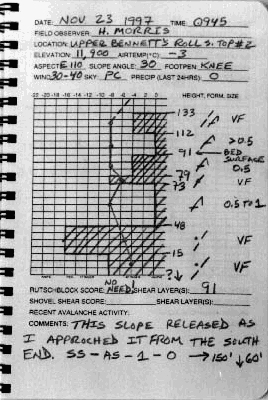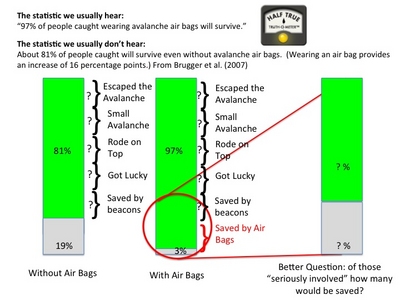casualI guarantee you that anyone on this site with the inclination and access to ski big terrain outside resort boundaries has a minimum of an Avy 1, a beacon, probe and shovel. At the very least. Or, the deep pockets to go on guided tours/helitrips/catskiing. Certain parts of the country....ahem Loveland Pass....have a reputation for attracting people with no training or equipment, but most people I come across who skin, tour,sled, etc. are very skilled and equipped.
You pretty much nailed it... however
I never took AVI 1.
I probably logged 40+ days in the backcountry last season and just as many out the resort gates (I will distinguish these, because while, apparently the word "Sidecountry" is dead, there is most certainly a difference). Many of these days were in remote terrain (sled or long skin access) that hadn't see another track all season.
Instead, I spent countless hours studying avalanches online, watching actual videos, reading books, talking with people more experienced than myself. By the time I stepped foot in the backcountry, I could practically recite the entirety of Bruce Tremper's "Staying Alive in Avalanche Terrain" and was far more knowledgeable than most AVI 1 participants.
Still, in the past 3 years, I've made more bad decisions than I could count. Most of the time, there was no consequence... A few times I got very lucky. Other's I know, far more experienced than I, didn't get so lucky. The more you learn and gain experience, the more you start to realize how little you really understand and control you have.
My point being, that just taking an Avalanche 1 course is just the bare minimum. Being able to safely navigate the backcountry is a skill you can never master. Even the best (often the best) lose their lives.
All of that being said, here are my personal suggestions from someone who has survived a mer 3 seasons in the backcountry:
1: Learn everything you can about the basics of avalanches (take AVI 1 or do a shit ton of studying)
2: Get really good with your beacon (as well as digging and probing technique)
3: Find a partner who better than you at the above. Listen to them. Question their decisions.
4: Read the local AVI report every morning. Pay attentions to event depth, elevation, and aspect
5: Accept that every time you go in the backcountry your putting you live at risk.
6: Everytime you ski attempt to calculate the chance that you will die. Decide if said "chance of death" is worth skiing
A few of the infinite factors that go into "chance of death":
* slope angle (obvious)
* snow pack (read reports, look for red flags)
* slope runout (if it does go... will you get spit out clean? into a terrain trap? into trees? off a cliff?)
* has there been recent activity? at a similar elevation? on the same aspect?
* has there been recent loading?
* which type of avalanche is most likely (soft, hard, wet)
* what layer is most likely to fail (how deep, how hard)
* how large potentially fail? (open face vs narrow shoot)
* how well do you REALLY know the snow pack (are you on vacation? are you skiing the same line you skied 10 days in a row?)
* tree density (high density can = stability. Anything less and you'll become a pinball even if it goes small)
* tree age (can give you insight into how often the slope slides big)
* will my partner be able to keep eyes on me?
Take time to consider each of these factors. If you still want to ski the line, then:
(A: You've picked a relativity good line
(B: Your crazy
(C: Your dumb
(D: Both (B and (C



























